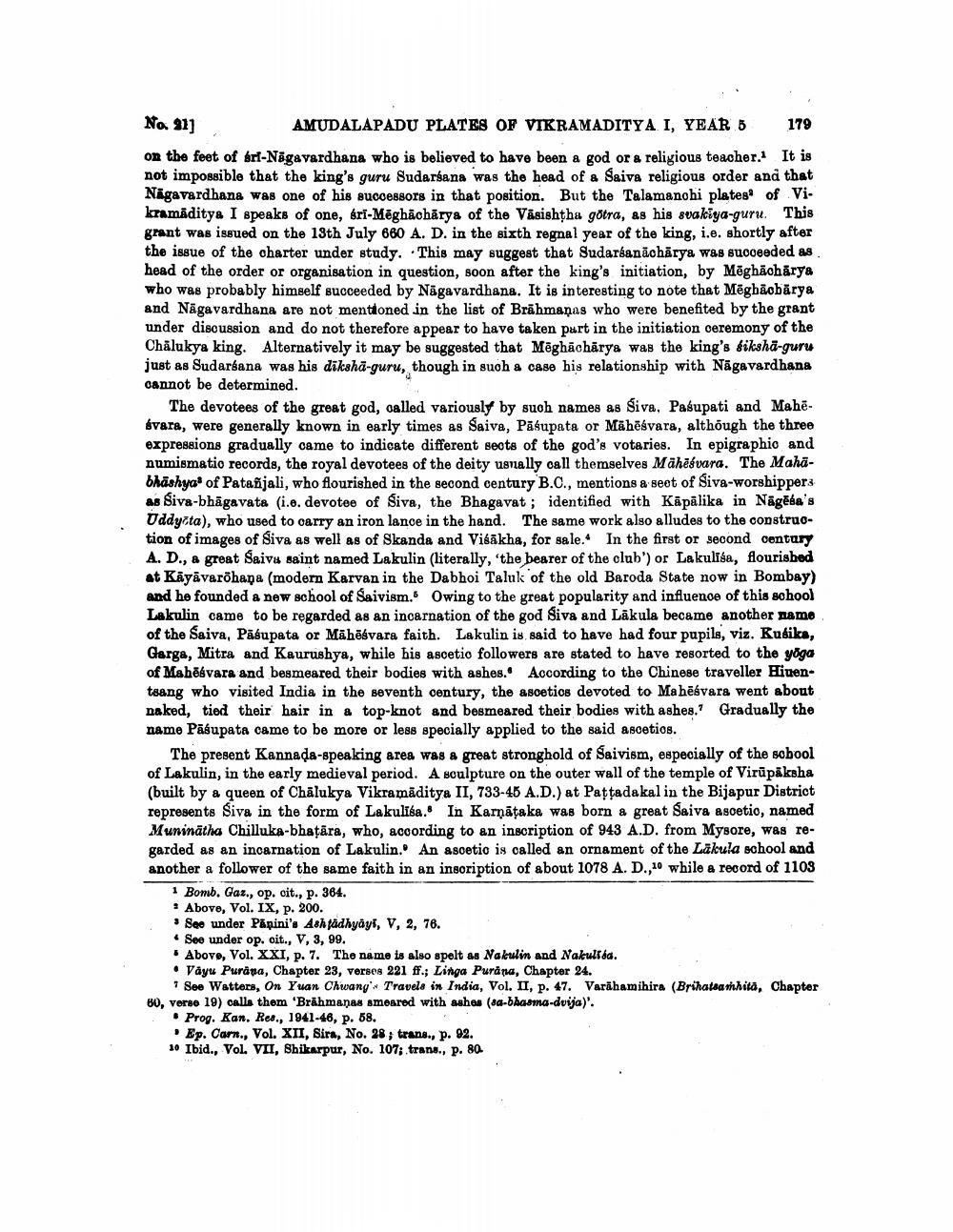________________
No 91]
AMUDALAPADU PLATES OF VIKRAMADITYA I, YEAR 5 179 on the feet of brf-Nögavardhana who is believed to have been a god or a religious teacher. It is not impossible that the king's guru Sudarsana was the head of a Saiva religious order and that Någavardhana was one of his successors in that position. But the Talamanohi plates of Vi. kramaditya I speaks of one, &ri-Mēghächārya of the Väsishtha götra, as his svakiya-guru. This grant was issued on the 13th July 660 A. D. in the sixth regnal year of the king, i.e. shortly after the issue of the charter under study. This may suggest that Sudarsanācārya was succeeded as head of the order or organisation in question, soon after the king's initiation, by Mēghacharya who was probably himself succeeded by Nägavardhana. It is interesting to note that Mēgbãobārya and Nāgavardhana are not mentioned in the list of Brāhmaṇas who were benefited by the grant under discussion and do not therefore appear to have taken part in the initiation ceremony of the Chalukya king. Alternatively it may be suggested that Mēghāchārya was the king's fiksha-guru just as Sudarsana was his dīksha-guru, though in such a case his relationship with Nāgavardhana cannot be determined.
The devotees of the great god, oalled variously by suoh names as Siva, Pasupati and Mahesvara, were generally known in early times as Saiva, Pasupata or Māhēśvara, although the three expressions gradually came to indicate different sects of the god's votaries. In epigraphic and numismatio records, the royal devotees of the deity usually call themselves Mähēsvara. The Mahabhäshyaof Patañjali, who flourished in the second century B.C., mentions a set of Siva-worshipper3 as Siva-bhāgavata (i.e. devotee of Siva, the Bhagavat; identified with Kāpālika in Nāgēéa's Uddyota), who used to carry an iron lance in the hand. The same work also alludes to the construotion of images of Siva as well as of Skanda and Vibākha, for sale. In the first or second century A. D., & great Saivu saint named Lakulin (literally, 'the bearer of the club') or Lakulisa, flourished at Käyāvaröhana (modern Karvan in the Dabhoi Taluk of the old Baroda State now in Bombay) and he founded a new school of Saivism. Owing to the great popularity and influence of this school Lakulin came to be regarded as an incarnation of the god Siva and Lākula became another namo of the Saiva, Pasupata or Mābēsvara faith. Lakulin is said to have had four pupils, viz. Kusika, Garga, Mitra and Kaurushya, while his ascetic followers are stated to have resorted to the yoga of Mahēgvara and besmeared their bodies with ashes. According to the Chinese traveller Hiuentsang who visited India in the seventh century, the ascetios devoted to Mahēsvara went about naked, tied their hair in a top-knot end besmeared their bodies with ashes. Gradually the name Pasupata came to be more or less specially applied to the said ascetios.
The present Kannada-speaking area was a great stronghold of Saivism, especially of the sobool of Lakulin, in the early medieval period. A sculpture on the outer wall of the temple of Virūpäksha (built by a queen of Chālukya Vikramāditya II, 733-45 A.D.) at Pațţadakal in the Bijapur District represents Siva in the form of Lakulisa. In Karnataka was born a great Saiva agoetio, named Muninātha Chilluka-bhatära, who, according to an inscription of 943 A.D. from Mysore, was regarded as an incarnation of Lakulin. An ascetic is called an ornament of the Lākula school and another a follower of the same faith in an insoription of about 1078 A. D.,10 while a record of 1103
1 Bomb. Gaz., op. cit., p. 364. . Above, Vol. IX, p. 200. See under Papini's Ashtadhyayk, V, 2, 76. See under op. cit., V, 3, 99.
Abovo, Vol. XXI, p. 7. The name is also spelt as Nakulin and Nakuli.a. • Vayu Purana, Chapter 23, verses 221 ff.; Linga Purana, Chapter 24.
* See Watters, On Yuan Chwang' Travels in India, Vol. II, p. 47. Varāhamihira (Brihatsamhita, Chapter 60. verse 19) calls them 'Brāhmaṇas smeared with ashes (sa-bhasma-dvija)'.
• Prog. Kan. Res., 1941-46, p. 58.
Ep. Carn., Vol. XII, Sira, No. 28; trans., p. 92. 10 Ibid., Vol. VII, Shikarpur, No. 107; trans., p. 80




